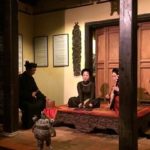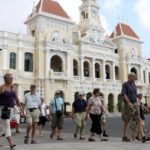Hang Gai Ward People’s Committee, in collaboration with curator Nguyen The Son and Young Artists Group “From Tradition to Tradition,” presents the thematic exhibition “The Story of the Street’s Communal House” at Ha Vi and Tu Thi Communal Houses in downtown Hanoi.
| The Parade celebrates the opening of thematic exhibitions at Hanoi’s Ha Vi and Tu Thi community houses. Photo: Cong Luan Newspaper |
The cultural event aims to celebrate the 18th anniversary of Vietnam’s Cultural Heritage Day, which falls on November 23, and the Hanoi People’s Committee’s recognition of the Hoan Kiem Lake area – its surroundings and the Old Quarter of Hanoi – as a city-level tourism zone.
The exhibition features a variety of Hanoi’s traditional handicrafts, such as silk, lacquer, and hand embroidery, as well as sketches and photographs of Hanoi, among others.
In addition, the new collection of brand identities of Ha Vi and Tu Thi Communal Houses will also be launched. By scanning the QR code, visitors can find useful information about these two communal houses, the map with directions to other relics on the website www.hoankiem360.vn.
Nguyen Quoc Hoan, Deputy Chairman of Hoan Kiem District People’s Committee, hoped that the activity would help attract tourists and contribute to the preservation of traditional crafts in Hanoi.
“The exhibition aims to promote Hanoi’s unique traditional handicrafts. It vividly depicts the historical history of Hanoi’s 36 handicraft streets,” he said.
| The lacquerware on display at the Ha Vi communal house. Photo: Cong Luan Newspaper |
In Hanoi’s Old Quarter, there are many communal houses dedicated to the patron saints of the guilds. Today, there are still 14 communal houses dedicated to guild patron saints. For example, the one on Hang Quat Street worships the founder of the fan craft; the Kim Ngan Temple worships the founder of the goldsmith guild; the Hoa Loc Thi Temple worships the ancestor of the dyeing craft and others.
The Ha Vi communal house at 11 Hang Hom Street is dedicated to Tran Lu, Vietnam’s patron saint of lacquering. The relic itself has an impressive architecture that bears artistic characteristics of the Nguyen dynasty: stone steles, bronze bells, worshipping cranes and thrones, spirit tablets, couplets, and horizontal inscribed boards.
Today, the newly restored Community House is like a mini-museum that vividly demonstrates the development of traditional handicrafts in the 36 streets of the ancient capital – Thang Long.
| The interior of Ha Vi Communal House. Photo: Cong Tho/ The Hanoi Times |
Meanwhile, the Tu Thi Communal House is located at 2A Yen Thai Street, which venerates Le Cong Hanh, the founder of the embroidery guild (1606 – 1661).
Embroidery has been practiced in Vietnam since the third century, but for a long time, artisans embroidered simple decorative motifs for royal fans or banners. In the 17th century, a high official, Le Cong Hanh, traveled to China as an envoy of King Le Chan Tong and learned more sophisticated embroidery. Upon his return, he taught the craft to the people of Quat Dong Village, Thuong Tin District, Hanoi.
Ancient house in Ma May
NDO – Ma May, a rare quarter that still retains several old houses, has created one of the characteristics of Hanoi. Hanoi’s streets are becoming increasingly crowded and traditional features can sometimes be hidden behind modern life. But if one takes the time to relax and look around, the ancient features begin to reveal themselves.











